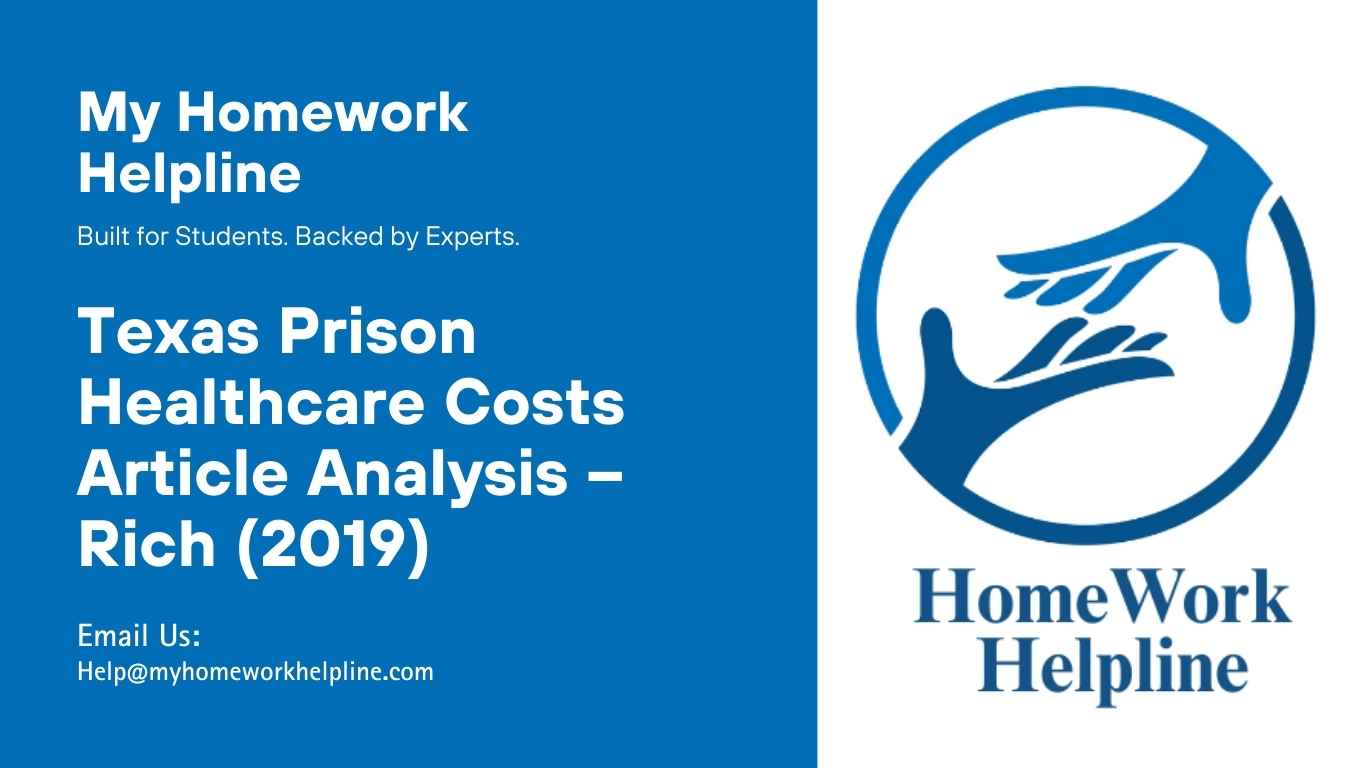Texas Prison Healthcare Costs and Aging Inmates: An Article Analysis of Rich (2019)
Rich’s (2019) article focuses on the issue of increasing prison health care costs in Texas. According to the article, Over the past years, although there have been fewer incarcerated individuals, there has been a significant surge in healthcare expenses in conjunction with the proportion of convicts who are elderly and unwell. Currently, every state is interested in providing treatment that complies with legal standards while capitalizing on incentives to enhance community well-being and decrease crime and recidivism. However, executing this objective may be costly. Furthermore, research has found that healthcare costs constitute approximately 20% of total prison expenses (The Pew Charitable Trusts, 2017). Such expenditures have increased substantially within the past few decades, and the trend is expected to continue, enhancing the impact of health provision on general prison expenses. As a result, policymakers and correctional authorities need to collaborate in achieving these goals through the most cost-effective approach. Therefore, I chose this particular article because such information is essential in determining the impact of correctional healthcare systems on universal objectives such as upholding legal standards, ensuring community safety and wellness, and exercising economic responsibility.
Need help breaking down complex readings like Rich’s (2019) Texas prison healthcare article? Our experts specialize in law assignment support and article analysis assistance. We simplify challenging criminal justice and policy topics into clear, structured insights for your coursework. Get reliable homework help today to strengthen your academic work and achieve the grades you deserve.
Rich’s (2019) article implies that the state-funded costs of treating inmates’ health issues have risen despite Texas’ incarceration rate declining over the past years. Moreover, healthcare expenditures keep increasing, and the Texas Department of Criminal Justice (TDCJ) continues to spend more than the revenue it collects. The rising expenditures may be linked to the aging jail population and expensive treatments for chronic conditions, including hepatitis, HIV, and cancer. For instance, during the 2019 fiscal year, Texas’ prison health care increased by more than half of the preceding year’s cost due to the aging and sicker prison population. As per Rich’s (2019) article, whereas the entire jail population fell by 3%, the proportion of convicts aged above 55 surged by 65%. Furthermore, convicts over 55 account for approximately one-eighth of the population but roughly one-half of the system’s healthcare expenditures.
Rich (2019) also implies that the Texas Department of Criminal Justice provides health treatment to roughly 150,000 jailed persons. Moreover, medical charges for the ten highest-priced illnesses exceeded $3 million as of 2019. E-Health and the availability of subsidized prescription medications through a national program are some of the key cost-cutting options. However, experts warn that systemic changes, such as paroling older convicts and removing individuals with psychological disorders or substance addiction from prison, are significant strategies to minimize costs.
In 1976, the United States Supreme Court ruled that inmates have a legal right to medical care. Since 1994, university providers from the University of Texas Medical Branch (UTMB) and Texas Tech University Health Sciences Center have administered medical assistance to Texas convicts. However, a class-action lawsuit was filed in September, claiming that TDCJ and UTMB infringed individuals’ fundamental rights by denying them treatment with prescription medications regarded as the accepted standard of care for Hepatitis C. The Food and Drug Administration approved the use of antiviral medication in 2011 that has efficacy above 90% and has become the standard treatment for all Hepatitis C patients (Rich, 2019). However, according to the lawsuit, TDCJ and UTMB officials only contemplate such treatment for detainees who already have liver damage, indicating that the sickness is causing extremely serious health hazards.
According to Rich (2019), at least 18,000 inmates in Texas have been identified with the virus, and almost 45,000 may be afflicted. Because Hepatitis C is frequently spread through needle sharing, prison populations throughout the country have a higher incidence of infected individuals. A disproportionate number of individuals that are addicted to narcotics are confined in correctional facilities (The Pew Charitable Trusts, 2017). The free-world prevalence of Hepatitis C is at 1.5%. In 2018, she reported that 12.9% of the inmate population was female. More than 50% of UTMB’s prescription drug expenses are attributed to HIV, and Hepatitis C. Hepatitis C medications are becoming extremely costly in recent years. This trend is projected to continue. According to McCullough (2019), the authority would not comment on ongoing lawsuits.
According to McCullough (2019), the expense per individual per treatment session in 2018 was $17,308, compared to a forecast of $63,000 in 2014. People suffering from mental illnesses are overrepresented in prison populations. Furthermore, jails are unhealthy environments. The Texas House intends to provide the state prison system with an additional $160 million to help with convict treatment. The Senate wishes to reduce funding. Even though neither budget provides the administration with anything near what it sought, the House budget increases the inmate care delivery budget by $159 million. In comparison, the Senate decreases it by around $1.3 million, resulting in a $160 million gap. TDCJ officials requested state lawmakers for an incremental $281 million in the upcoming two-year budget cycle, which they said was needed.
With rising healthcare spending and an aging prisoner demographic, the criminal justice system consistently incurs hospital expenses that are substantially beyond the funds provided by the state. TDCJ called its proposed funding increase essential in its budget proposal. At the same time, the correctional healthcare system has a standard funding level of nearly $1.1 billion for the current fiscal year, based on the Legislative Budget Board (McCullough, 2019). The money is spent on providing convicts with medical, dental, and mental health care. In addition, both houses advocated increasing financing for vocational training programs and installing more video monitoring cameras in maximum-security prisons.
The Author’s Conclusions and Recommendations
Rich (2019) states that terminally ill inmates with substantial physical or psychological deficiencies are eligible for Medically Recommended Intensive Supervision in Texas. Persons sentenced for a grave offense, such as homicide, molestation, or burglary with a lethal weapon, however, are not eligible for parole unless they suffer from a life-threatening disease or require extensive care. UTMB also refers everyone who meets the criteria to the Texas Correctional Office for Offenders with Medical or Mental Impairments. Over 2,100 convicts were assessed in 2018, but only 63 were granted parole. According to a TDCJ official, offenders who have already been accepted for parole, do not fulfill clinical standards, or decline medical parole may be disqualified.
In addition, many older inmates have served lengthy sentences for heinous offenses but no longer constitute a threat to the community. According to Rich (2019), more than 10,000 offenders over 55 are detained for serious criminal charges. Therefore, researchers recommend rethinking the qualifying criteria, such as who qualifies as terminally ill, and involving health personnel in parole decision-making. Politicians can also reduce costs by preventing individuals from joining the system altogether. The Committee would then aim to divert more persons with mental disorders and addictions into treatment-based facilities. This approach would be the most effective in minimizing costs. Also, when individuals are prevented from delving deeper into the criminal justice system, this would signify victory to everyone.
My Conclusions and Recommendations
Elderly individuals who are incarcerated, like senior persons outside, are more vulnerable to suffering from dementia, decreased mobility, and diminished hearing and sight (The Pew Charitable Trusts, 2017). These illnesses provide unique issues in prisons, necessitating greater staffing levels and expanded officer training to manage inmates who have trouble conforming to corrections officers’ commands. Structure accessibility adaptations, such as customized housing and wheelchair ramps, may also be required.
Furthermore, according to the Bureau of Justice Statistics, elderly convicts are much more vulnerable to pricey chronic medical illnesses (The Pew Charitable Trusts, 2017). Due to factors like substance use disorder, insufficient preventative and primary care before imprisonment, and stress related to the confinement and sometimes violent atmosphere of the prison environment, they usually suffer the consequences of aging earlier than persons outside prison. For these reasons, older people have a significant impact on correctional costs.
References
McCullough, J. (2019, January 18). Duelling Texas budget plans tens of millions apart on prisoner health care. The Texas Tribune. Retrieved September 12, 2022, from https://www.texastribune.org/2019/01/18/texas-prisons-health-care-texas-legislature-budget-proposals/
Rich, D. (2019, November 27). Texas prison health costs are rising. Experts cite an ageing population. The Texas Tribune. Retrieved September 12, 2022, from https://www.texastribune.org/2019/11/25/texas-prison-health-care-budget-parole/
The Pew Charitable Trusts. (2017, October). Prison health care: Costs and quality: How and why states strive for high-performing systems. In pewtrusts.org. Retrieved September 12, 2022, from https://www.pewtrusts.org/-/media/assets/2017/10/sfh_prison_health_care_costs_and_quality_final.pdf

